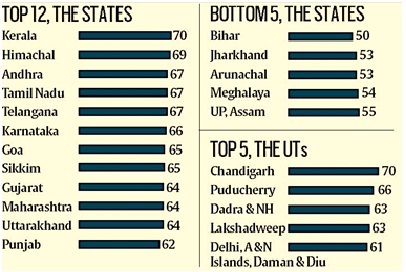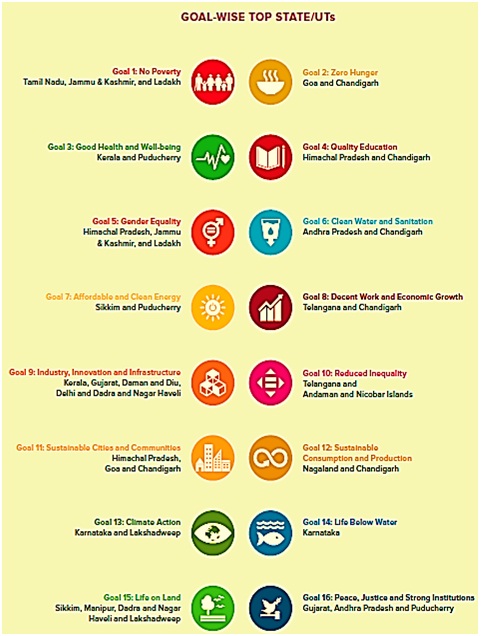Niti Aayog’s Sustainable Development Goals Index
- 02 Jan 2020
- On 30th December, 2019, NITI Aayog launched the second edition of the Sustainable Development Goals (SDG) India Index, which comprehensively documents the progress made by India’s States and Union Territories towards achieving the 2030 SDG targets.
Objectives
- Promote healthy competition and emulation among States & UTs within the framework of cooperative federalism.
About the SDG Index
- The SDG India Index, first developed in 2018, was an attempt to present the achievements on the SDGs across the sub-national entities.
- The SDG India Index has been developed in collaboration with the Ministry of Statistics and Programme Implementation (MoSPI), United Nations in India, and Global Green Growth Institute.
- While the SDG Index- 2018 was based on 13 Goals, the SDG Index-2019 is based on 16 goals across 54 targets spread among 100 indicators based on national identified indicators and is also better aligned with the SDG National Indicator Framework.
- A composite score was computed in the range of 0–100 for each State/UT based on its aggregate performance across 16 SDGs, indicating the average performance of every State/UT towards achieving 16 SDGs and their respective targets. If a State/UT achieves a score of 100, it signifies it has achieved the 2030 national targets. The higher the score of a State/UT, the closer it is towards achieving the targets.
- Classification criteria based on SDG India Index score is as follows:
- Aspirant: 0–49
- Performer: 50–64
- Front Runner: 65–99
- Achiever: 100
Major Highlights
Overall India’s Performance towards SDGs
- India's composite score improved from 57 in 2018 to 60 in 2019-20 with major success in water and sanitation, power and industry.
- India’s ranking in terms of poverty has fallen from 54 points in 2018 to 50 points in 2019.
- The maximum gains been made in Goals 6 (clean water and sanitation), 9 (industry, innovation, and infrastructure) and 7 (affordable and clean energy).
- On two goals in particular — gender equality and zero hunger — far greater attention is required as the country’s score on both is less than 50.
- Further, India has slipped a point down, from 65 to 64 as far as economic growth goes.
State and UT’s Performance
- Kerala(70), Himachal Pradesh, Andhra Pradesh, Tamil Nadu and Telangana are the better performing States.
- Bihar(50), Jharkhand, Arunachal Pradesh, Meghalaya and Uttar Pradesh are the bottom most States.
- Chandigarh maintained its top spot among the UTs with a score of 70.
- Uttar Pradesh, Odisha and Sikkim have shown maximum improvement, but states like Gujarat have not shown any progress vis-a-vis 2018 rankings.
- In 2019 Index, five more states were included in the Front Runner category - Andhra Pradesh, Telangana, Karnataka, Sikkim and Goa.

Source: IE

Source: NITI Aayog
Significance
- Tool of Assessment: The Index serves as a useful instrument to judge the progress of the States/UTs in adopting and implementing the SDG agenda, where each State and Union Territory stands with regard to achieving the Sustainable Development Goals.
- Help to Identify Priority Areas: It presents a more robust framework for measuring the progress on SDGs at the sub-national level and supports States and UTs to identify priority are as in which they need to invest and improve by enabling them to measure incremental progress.
- Devising Better Strategy: It will help the states to sort out the reasons for differential performance and devise better strategies to achieve the SDGs by 2030.
- In Alignment with Government’s Mission: The Index acts as a bridge, aligning the SDGs with the Government’s clarion call of Sabka Saath, Sabka Vikas, Sabka Vishwas, which embodies the five Ps of the global SDG movement - people, planet, prosperity, partnership and peace.
Limitations of the Index
|
Way Forward
- India, with the world’s 17 percent of the population, faces multiple challenges in several sectors of development, be it health, nutrition, education, sanitation and infrastructure. However, these challenges also make India conducive for developing innovative solutions to address them and also provide a useful lens for solving similar problems in other parts of the world.
- India is fully committed to achieving the Global Goals within the specified timelines. The country is well aware of the prospect that if India does not meet the SDGs, the world will be far from achieving them.
- In this direction, the SDG Index is a powerful tool which offers excellent possibilities for the States/UTs to identify priority areas which demand action, facilitate peer learning, highlight data gaps, steering the country towards the achievement of SDGs.




